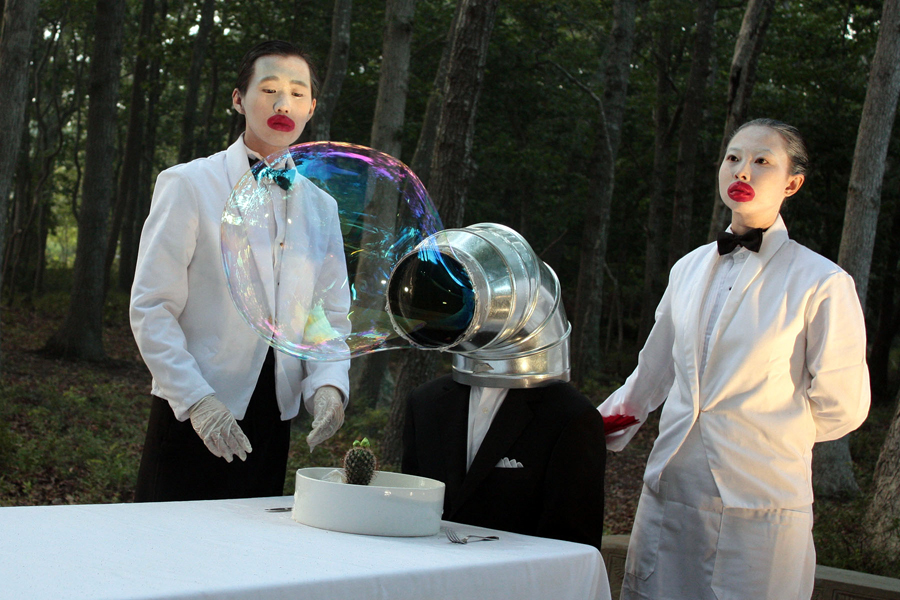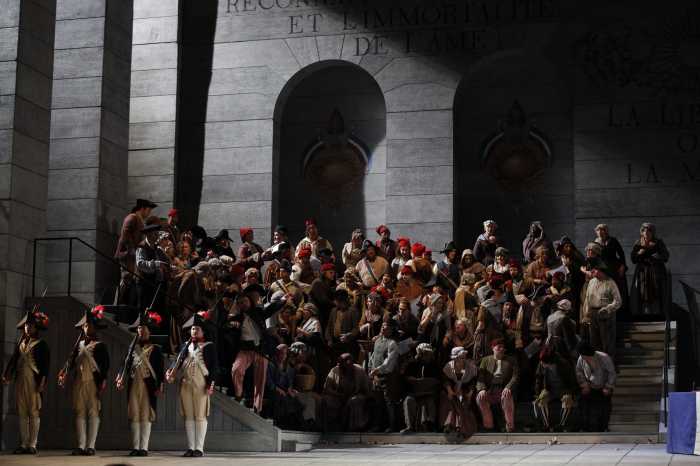Changes: Western Union, Weather Control and the Watermill Center

Back in the 1970s, I wrote a series of articles about Scotty McPherson, who ran what I called the Weather Center in Water Mill.
He was a mythical character, modeled after “Scotty” from the TV series Star Trek, which had run in the late 1960s.
Whenever a big storm or hurricane would loom in the South Atlantic, I would call him on the telephone. We had very inaccurate weather forecasting in those years, and I thought it important to readers of Dan’s Papers that we get an advance and perhaps more accurate prediction about whether it would hit the East End. There were many who remembered how the Hurricane of ’38 had hit Westhampton Beach with almost no advance notice, killing hundreds of people as it swept through.
McPherson worked running the Hampton Weather Center at a formerly abandoned three-story factory deep in the woods of Water Mill. His job involved overseeing workmen shoveling coal into over 100 furnaces on that site. The huge amount of energy created by this, directed by scientists reading printouts from computers the size of trucks on the property, would result in cosmic energy and steam pouring out of the smokestacks of this building so that, if things went well, approaching storms could be driven off course and out to sea off Montauk, instead of striking the mainland.
Hurricanes had begun to be given names by that time.
“We’re shoveling as fast as we can,” McPherson would shout over the din of the furnaces and the power generators roaring in the background. “I dunno what we can do with this one.”
We’d talk about a recent failure or success and though he might be encouraging that they’d be able to control this one, in the end, he’d always hedge his bets. It basically was the same conversation that Scotty in the engine room would have with Captain Kirk.
I continued with this for a number of years, but eventually, with the invention of really smart computers, nuclear power, accurate weather reporting, the discovery of global warming—which put an alarming spin on anything thrown into the atmosphere and a few other minor things—I could not continue on with this particular fantasy.
I never did forgot that abandoned Western Union factory, however. And once, I even went looking for it. It was deep in the woods in Water Mill somewhere. There were no signs directing one to it, it was not on any paved road. Eventually, after going down trails that led nowhere, I gave up and came home.
I did imagine, however, that in the even earlier days at this very large building, Western Union had sorted out and sent telegrams this way and that. And of course, I imagined that some sort of research was being done there to improve the service. On the other hand, when it was taken over by Scotty’s Water Mill Weather Center in my mind, that all came to an end.
What did happen to that abandoned building in reality, in the early 1990s, is that it was taken over and fixed up by the celebrated playwright, installation artist and director Robert Wilson, who turned it into his home base, the Watermill Center. He spends several months a year creating performances, sculptures, operas, tableaus and other projects all over the world, but in the summer he comes home to Water Mill and to his eight-and-a-half acre “Center” there. He loves the light here, he has said.
I did visit him there in the early years. It was actually the first time I had been there, and it was surely easy to see how this red brick three-story factory building, looking much like the Watchcase factory in Sag Harbor now being restored, could mess with telegrams and divert hurricanes.
Since then, Wilson has completely redesigned and expanded this building, to the point that it’s unrecognizable from its earlier incarnation(s). And every summer, he holds a fundraiser there, where people come to have cocktails and dinner and view the living art installations and performances he creates there for the occasion. At this past year’s, his 20th, among the hundreds of guests were Hugh Jackman, Winona Ryder, Cindy Sherman, Marina Abramovic, Lady Gaga and, separately, a French woman by the name of Orlan, who sued Lady Gaga for what she said was plagiarism of her body modification inventions. But that’s a whole other story. The fundraiser raised $1.85 million this year.
In any case, I didn’t know of a particularly unusual connection between Robert Wilson, the Western Union building, Albert Einstein, possibly the Weather Center and this reporter, until I read about Wilson’s triumphant series of performances and displays now going on in Paris. As a climax to a world tour, he’s being showcased at the Louvre, where they’ve given a series of galleries over to him in what they call a “residency,” rarely offered to a living artist. Elsewhere in Paris there are performances of his work The Old Woman starring Mikhail Baryshnikov and Willem Defoe; his opera Madama Butterfly and his sobering take on Peter Pan, both at the Paris Opera; and a revival of his seminal work, the opera Einstein on the Beach, at the Theatre du Chatelet.
Einstein on the Beach, created and directed by Wilson and Phillip Glass, had its world premiere on stage in Paris in 1976 and, according to a recent article in The New York Times, brought these two young SoHo artists to the attention of the world at large.
“I think Bob Wilson might not have ever emerged from the New York downtown avant-garde scene of the ’70s, had it not been for French audience support and government support,” Margery Arent Safir, the general editor of a collection of essays about Wilson, told the Times.
Wilson had produced a performance of Deafman Glance, in 1972 at the Nancy Festival and later in Paris, which was praised by poet Louis Aragon, who claimed that Wilson was the true heir to the Surrealists. Then in 1976 came the six-hour Einstein on the Beach, which caused a sensation. “This totally set Bob up,” Safir told the Times, although not, right away, in New York City. A few months after the premiere, Glass and Wilson did succeed in bringing this production to New York. There, the Metropolitan Opera refused to produce it but did allow a company headed up by the two artists to rent the theater for a night. (Tickets sold out in two days).
Why is all this of such interest?
Einstein on the Beach is the connection to it all.
According to the Times, this production was basically about the idea that Einstein, a well-known pacifist living in America after emigrating from Germany, was largely responsible for the development of the atomic bomb.
Indeed, Einstein wrote a letter to President Roosevelt in 1939 urging him to put a group of scientists together to create such a bomb. He wrote it while on a summer vacation in a cottage on eastern Long Island at Nassau Point, at the urging of two physicists who came to see him there. These physicists, Leo Szilard and Eugene Wigner, were worried the Germans were going to produce such a bomb and be able to destroy an American city in one blow. We needed to beat them to the punch. Directly as a result of this letter from Einstein, who was world famous by that time, Roosevelt secretly ordered the creation of a scientific facility in the mountains of Oak Ridge, Tennessee, which, still during the war, six years later, split the atom and figured out how to use it for an atomic bomb.
This is a well-known piece of history that took place on the eastern end of Long Island, although the existence of the letter was not revealed until after the war and the details of it all not until 10 years later. Did Einstein send a telegram to President Roosevelt in the White House that, perhaps, was handled by the giant Western Union facility in Water Mill? Indeed, in recent years, it’s been learned that this letter was not sent the ordinary way. Believing that even a telegram would not get the attention of the President, Einstein and his colleagues arranged to hand deliver it to Alexander Sachs, a banker they knew who was in frequent contact with the President. In the event, it took two months to get from Southold to Roosevelt’s desk.
Not long ago, I saw this letter. It was on display under a spotlight at the Museum of Natural History in New York, in an exhibit about New York World War II memorabilia. I snuck a picture of it.
In age, Robert Wilson is a contemporary of mine. We are both in our mid-70s. I got here as a teenager in the 1950s, and he came, although I did not know him then, in the 1970s. And then, in 1976, he and Philip Glass, in Manhattan, created Einstein on the Beach. It was a true collaboration. It involves seven sets for the nine acts (two appear twice), all designed by Wilson, in front of which the singers, dancers and actors perform the opera about Einstein’s nuclear dilemma and other aspects of his life. In addition, there are four interludes, which the pair call “knee plays” since they are performed while the curtains are closed during the time the seven sets by Wilson (two twice) are assembled between the acts. They act as knees connecting shin and thigh. As I said, the whole performance takes six hours. The audience is allowed to come and go.
This was surely unique in American—or any other—opera at that time, all based on a letter sent from eastern Long Island years before.
Recently, I have thought of reviving the Weather Center and having Scotty, all cleaned up, manipulating the weather with lasers and lightning bolts from here that might have a positive effect on the atmosphere.
If he were to come back, though, with the old center no longer available, he would be in a tough position. With skyrocketing real estate prices here, I seriously doubt he and his Trekkies could afford a place, so it might be necessary to find an angel to donate a property. Any offers?









